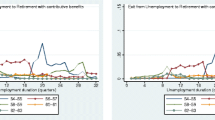Abstract
Pension benefits in old age establish a disincentive to save in youth, thereby yielding lower levels of capital stock and the wage rate. As a result, the trade union has an incentive to change the composition of its two targets: employment and the wage rate. This paper develops a model that includes employment effects of public pensions via capital accumulation and union wage setting. Within this framework, we consider how contribution rates to the pension system influence the level and time path of the unemployment rate. It is demonstrated that (1) a higher contribution rate results in a lower unemployment rate, and (2) the economy with a high (low) contribution rate experiences monotone convergence towards (oscillatory convergence towards or a period-2 cycle around) the steady state.
Similar content being viewed by others
References
Andolfatto, D., Gervais, M.: Social security, the payroll tax, and endogenous debt constraints. University of Waterloo and Federal Reserve Bank of Richmond (mimeo) (2001)
Auerbach A.J., Kotlikoff L.J. (1987) Dynamic Fiscal Policy. Cambridge University Press, Cambridge
Blanchard, O.J.: Revisiting European unemployment: unemployment, capital accumulation and factor prices. NBER Working Paper No. 6566 (1998)
Bräuninger M. (2000) Wage bargaining, unemployment and growth. J Inst Theor Econ 156, 646–660
Bräuninger M. (2005) Social security, unemployment, and growth. Int Tax Public Finance 12, 423–434
Coimbra R., Lloyd-Braga T., Modesto L. (2005) Endogenous fluctuations in unionized economies with productive externalities. Econ Theory 26, 629–649
Conesa J., Krueger D. (1999) Social security reform with heterogeneous agents. Rev Econ Dyn 2, 757–795
Corneo G., Marquardt M. (2000) Public pensions, unemployment insurance, and growth. J Public Econ. 75, 293–311
Daveri F., Tabellini G. (2000) Unemployment, growth and taxation in industrial countries. Econ Policy 30, 47–88
Diamond P. (1965) National debt in a neoclassical growth model. Am Econ Rev 55, 1126–1150
Futagami K., Nakajima T. (2001) Population aging and economic growth. J Macroecon 23, 31–44
Gertler M. (1999) Government debt and social security in a life-cycle economy. Carnegie-Rochester Conf Public Policy 50, 61–110
Hubbard R.G., Judd K.L. (1987) Social security and individual welfare: precautionary saving, borrowing constraint, and the payroll tax. Am Econ Rev 77, 630–646
Imoto S. (2003) An example of nonlinear endogenous business cycle model: build in the trade union. Econ Lett 81, 117–124
İmrohoroğlu A., İmrohoroğlu S., Joines D.H. (1995) A life cycle analysis of social security. Econ Theory 6, 83–114
İmrohoroğlu A., İmrohoroğlu S., Joines D.H. (1998) The effect of tax-favored retirement accounts on capital accumulation. Am Econ Rev 88, 749–768
İmrohoroğlu A., İmrohoroğlu S., Joines D.H. (1999) Social security in an overlapping generations model with land. Rev Econ Dyn 2, 638–665
Kaas L., von Thadden L. (2003) Unemployment, factor substitution and capital formation. Ger Econ Rev 4, 475–495
Kaas L., von Thadden L. (2004) Budgetary policy and unemployment dynamics in an OLG model with collective bargaining. Econ J 114, 867–889
Kaganovich M., Zilcha I. (1999) Education, social security and growth. J Public Econ 71, 289–309
Lucas R. (1988) On the mechanics of economic development. J Monet Econ 22, 3–42
Marchand M., Michel P., Pestieau P. (1996) Intergenerational transfers in an endogenous growth model with fertility changes. Eur. J Polit Econ 12, 33–48
Pecchenino R.A., Pollard P.S. (1997) The effects of annuities, bequests, and aging in an overlapping generations model of endogenous growth. Econ J 107, 26–46
Pecchenino R.A., Pollard P.S. (2002) Dependent children and aged parents: funding education and social security in an aging economy. J Macroecon 24, 145–169
Pecchenino R.A., Utendorf K.R. (1999). Social security, social welfare and the aging population. J Popul Econ 12, 607–623
Pencavel J. (1984) The trade-off between wages and employment in trade union objectives. Q J Econ 99, 215–232
Romer P. (1986) Increasing returns and long-run growth. J Polit Econ 94, 1002–1037
Rojas, J.A., Urrutia, C.: Social security reform with uninsurable income risk and endogenous borrowing constraints. Banco de Espa ña and ITAM (mimeo) (2006)
Saint-Paul G. (1992) Fiscal policy in an endogenous growth model. Q J Econ 107, 1243–1259
Storesletten K., Telmer C.I., Yaron A. (1999) The risk-sharing implications of alternative social security arrangements. Carnegie-Rochester Conf Ser Public Policy 50, 213–259
Zhang J. (1995) Social security and endogenous growth. J Public Econ 58, 185–213
Zhang J., Zhang J. (1995) The effects of social security on population and output growth. South Econ J 62, 440–450
Author information
Authors and Affiliations
Corresponding author
Additional information
The author would like to thank an anonymous referee, Kazutoshi Miyazawa, and seminar participants at Osaka University for their useful comments and suggestions, and Masako Ikefuji and Hiroaki Yamagami for their research assistance. Financial support from the Japan Society for the Promotion of Science (JSPS) through a Grant-in-Aid for Young Scientists (B) (No.17730131), the Asahi Glass Foundation, the Japan Economic Research Foundation and the 21st Century COE Program (Osaka University) is gratefully acknowledged. All remaining errors are mine.
Rights and permissions
About this article
Cite this article
Ono, T. Unemployment dynamics in an OLG economy with public pensions. Economic Theory 33, 549–577 (2007). https://doi.org/10.1007/s00199-006-0150-2
Received:
Accepted:
Published:
Issue Date:
DOI: https://doi.org/10.1007/s00199-006-0150-2




